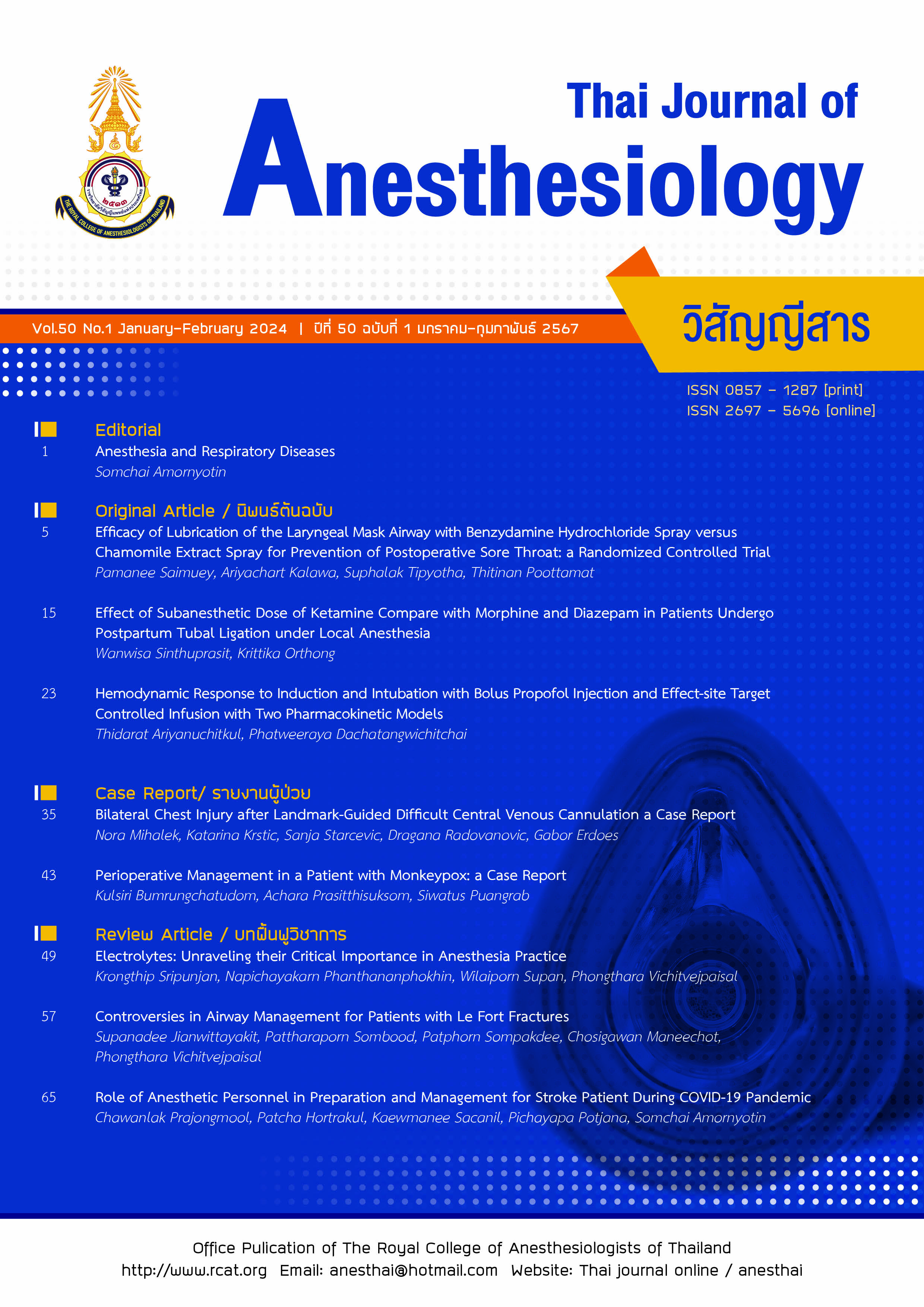Effect of Subanesthetic Dose of Ketamine Compare with Morphine and Diazepam in Patients Undergo Postpartum Tubal Ligation under Local Anesthesia
Main Article Content
Abstract
Background: The use of opioid in postpartum tubal ligation (TR) patients can result in delayed gastric emptying time, and thereby increasing the aspiration risk. Opioid is also associated with sedation, respiratory depression as well as nausea and vomiting. A subanesthetic dose of ketamine can reduce pain and postoperative opioid used with no respiratory depression. The objective of the study is to compare the analgesic effect of subanesthetic dose of ketamine with morphine and diazepam in patients undergoing tubal ligation under local anesthesia. Methods: This study was a double-blinded randomized controlled trial. Forty patients underwent tubal ligation under local anesthesia with 2% lidocaine with epinephrine 20 ml were randomly assigned into two groups. Group S received ketamine 0.3 mg/kg iv. Group C received morphine 0.1 mg/kg iv and diazepam 5 mg iv. Results: Mean of numerical rating scale (NRS) in group S was 2.3±1.8 which was significantly less than group C (4.7±1.6). NRS while tying the fallopian tubes, TR1 and TR2 in group S were 2.5±2.9, 4.5±3.7 which less than group C 5.6±2.1, 6.7±1.9, significantly (P=0.0006, 0.0214). However, there was no difference in mean NRS at postoperative period. Conclusion: The use of subanesthetic dose of ketamine (0.3 mg/kg iv) provides greater intraoperative analgesia than the use of morphine and diazepam in patients undergoing postpartum tubal ligation under local anesthesia.
Article Details

This work is licensed under a Creative Commons Attribution-NonCommercial-NoDerivatives 4.0 International License.
References
Huffnagle S, Huffnagle HJ. Anesthesia for postpartum tubal ligation. Tech Reg Anesth Pain Manag. 2003;7:222-8.
Bucklin BA. Postpartum tubal ligation: timing and other anesthetic considerations. Clin Obstet Gynaecol. 2003;46:657-66.
Kurdi MS, Theerth KA, Deva RS. Ketamine: current applications in anesthesia, pain, and critical care. Anesth Essays Res. 2014;8:283-90.
Laskowski K, Stirling A, McKay WP, Lim HJ. A systematic review of intravenous ketamine for postoperative analgesia. Can J Anaesth. 2011;58:911-23.
Gorlin AW, Rosenfeld DM, Ramakrishna H. Intravenous sub-anesthetic ketamine for perioperative analgesia. J Anaesthesiol Clin Pharmacol. 2016;32:160-7.
Jouguelet-Lacoste J, La Colla L, Schilling D, Chelly JE. The use of intravenous infusion or single dose of low-dose ketamine for postoperative analgesia: a review of the current literature. Pain Med. 2015;16:383-403.
Grace RF, Lesteour T, Sala T, Stewart J. A randomized comparison of low-dose ketamine and lignocaine infiltration with ketamine-diazepam anaesthesia for postpartum tubal ligation in Vanuatu. Anaesth Intensive Care. 2001;29:30-3.
Motov S, Rosenbaum S, Vilke GM, Nakajima Y. Is there a role for intravenous subdissociative-dose ketamine administered as an adjunct to opioids or as a single agent for acute pain management in the emergency department? J Emerg Med. 2016;51:752-7.
Ely EW, Truman B, Shintani A, et al. Monitoring sedation status over time in ICU patients: reliability and validity of the Richmond Agitation Sedation Scale (RASS). JAMA. 2003;289:2983-91.
American Society of Anesthesiologists Task Force on Obstetric Anesthesia. Practice guidelines for obstetric anesthesia: an updated report by the American Society of Anesthesiologists Task Force on Obstetric Anesthesia. Anesthesiology. 2016;124:270-300.
Kaur S, Saroa R, Aggarwal S. Effect of intraoperative infusion of low-dose ketamine on management of postoperative analgesia. J Nat Sci Biol Med. 2015;6:378-82.
Laskowski K, Stirling A, McKay WP, Lim HJ. A systematic review of intravenous ketamine for postoperative analgesia. Can J Anaesth. 2011;58:911-23.
Elia N, Tramèr MR. Ketamine and postoperative
pain-a quantitative systematic review of
randomised trials. Pain. 2005;113:61-70.
Schwenk ES, Viscusi ER, Buvanendran A, et al. Consensus guidelines on the use of intravenous ketamine infusions for acute pain management from the American Society of Regional Anesthesia and Pain Medicine, the American Academy of Pain Medicine, and the American Society of Anesthesiologists. Reg Anesth Pain Med. 2018;43:456-66.
Pendi A, Field R, Farhan SD, Eichler M, Bederman SS. Perioperative ketamine for analgesia in spine surgery: a meta-analysis of randomized controlled trial. Spine (Phila Pa 1976). 2018;43:E299-307.
Hallway A, Vu J, Lee J, et al. Postoperative opioid-sparing pathway does not compromise patient satisfaction or pain control. J Am Coll Surg. 2019;229:316-22.


